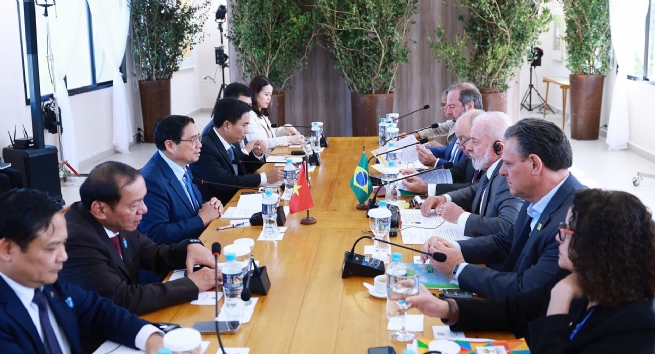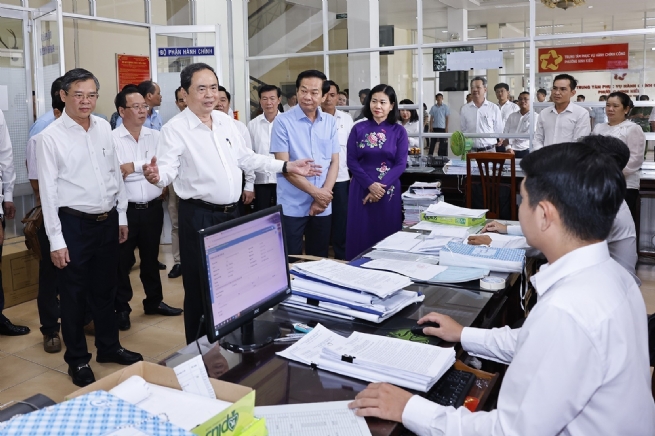80 Years of Economic Self-Reliance, Resilience, and Global Integration
From a war-torn economy, Vietnam has steadily overcome numerous challenges to become one of the most dynamic economies in Asia. Over 80 years of development, Vietnam’s economic journey reflects self-reliance, a commitment to innovation, and determined efforts toward full integration.

Vietnamese Prime Minister Pham Minh Chinh and Brazilian President Luiz Inacio Lula da Silva discuss advancing the Vietnam-MERCOSUR and Vietnam-Brazil FTA negotiations, July 2025
Miracle of relentless effort
Since gaining independence in 1945, Vietnam’s economy has followed a challenging but resilient and progressive path. In the early years of nation-building and resistance, the economy was largely self-sufficient, relying on domestic resources, subsidies, and a planned economic model. After 1975, industry and infrastructure gradually developed; production of cement, coal, and steel grew significantly, and projects such as Bim Son Cement Plant and Hoa Binh Hydropower Plant provided the foundation for future growth.
Despite these advances, the economy continued to face difficulties, high inflation, and an outdated subsidy model. The decisive turning point came with the Sixth National Party Congress in 1986, when Vietnam transitioned from a centrally planned economy to a socialist-oriented market economy, introducing a multi-sector approach, reforming state-owned enterprises, implementing household contracting, and overhauling financial and banking systems. Early results were clear: average GDP growth reached 4.4% per year from 1986 to 1990 and 7% per year from 1991 to 2000. Inflation fell sharply from 453.5% in 1986 to 95.8% in 1989 and 37.7% in 1992. Export turnover in 2000 reached US$14.45 billion, 18.3 times higher than in 1986.
From 2001 to 2020, Vietnam continued its breakthrough with average GDP growth of 6.58% per year. GDP per capita reached US$2,779 in 2020, 5.57 times higher than in 2000, lifting Vietnam out of the low-income group and surpassing the lower-middle-income threshold. The non-state sector accounted for 50.56% of GDP, while the state sector contributed around 20.66%. The FDI sector accounted for over 70% of export turnover. Total goods exports in 2020 reached US$282.6 billion, 19.5 times higher than in 2000.

Chairman of the National Assembly Tran Thanh Man pays a working visit to the Ninh Kieu Ward Administrative Center
Notably, from 2020 to the present, Vietnam has maintained sustainable growth. By 2024, GDP reached US$476.3 billion, 59.5 times higher than in 1986 (around US$8 billion). National brand value in 2024 was estimated at US$507 billion, ranking 32nd globally. The poverty rate has fallen from 58% in 1993 to under 3% in 2024. The middle-class share reached 13% in 2022, projected to rise to 26% by 2026. Disbursed FDI in 2024 reached a record US$25 billion, and in the first half of 2025, approximately US$11.72 billion, an 8.1% increase and the highest for any first half of the 2021-2025 period. Import-export turnover reached nearly US$800 billion in 2024, with US$432.03 billion in the first half of 2025, maintaining double-digit growth compared to the same period the previous year.
Vietnam has transformed from a backward agricultural economy to modern industrialization and service sectors. The share of agriculture, forestry, and fisheries has fallen below 12%, while industry and services play a dominant role. Key industries such as information technology, telecommunications, manufacturing, textiles, footwear, semiconductors, and high-tech industries increasingly assert their role in the global value chain.
According to General Secretary To Lam, nearly 40 years of reform have marked a resilient and breakthrough Vietnam with a strong desire for development. From a centrally planned, inefficient economy with a per capita income of just US$96 in 1989, Vietnam has risen strongly, and by the end of 2025, it is expected to enter the group of upper-middle-income countries, with per capita income above US$5,000 per year. This achievement reflects not only the correct development policies under the Party’s leadership with bold, decisive institutional, policy, and integration reforms but also the diligent, creative, determined efforts of the entire nation.
Vietnam continues to promote major reforms to enhance state management efficiency and achieve sustainable socio-economic development. A notable measure is the merger and adjustment of provincial and district boundaries to streamline administration, reduce overlaps, and optimize management resources. Consolidating administrative units has cut costs, improved management efficiency, and facilitated local economic development.
Simultaneously, Vietnam has restructured state apparatuses toward greater efficiency by merging and consolidating ministries, ministerial-level agencies, and related bodies to reduce functional overlaps, enhance professionalism, and improve inter-agency coordination. At the same time, the application of information technology and digital transformation in government operations has improved administrative procedures, creating a transparent and convenient environment for citizens and businesses.
Enhancing Vietnam’s position on the international stage
From a country under embargo, Vietnam joined the World Bank (WB), the International Monetary Fund (IMF), and the Asian Development Bank (ADB) in 1993; Asia-Pacific Economic Cooperation (APEC) in 1998; signed a trade agreement with the United States in 2000; joined the World Trade Organization (WTO) in 2007; and has now participated in more than 17 free trade agreements with countries worldwide.
Many positive assessments from reputable international financial institutions, including the WB, IMF, and ADB, highlight Vietnam’s increasingly important role in the regional and global economy. According to the WB, Vietnam is a “notable development story,” rising from a poor country with per capita income below US$700 in 1986 to nearly US$4,500 in 2023. The WB also recognized Vietnam’s significant achievements in poverty reduction and its considerable potential for future economic growth.

Vingroup showcases its excellence at the exhibition celebrating Vietnam’s 80 years of achievements
The ADB has also expressed positive views on Vietnam, forecasting stable growth and noting the leading role of exports, foreign direct investment, and public investment disbursement. A stable macroeconomic foundation, along with a large trade surplus (US$24.3 billion in 2024), helps Vietnam maintain its appeal to international investors. The IMF, in its Article IV report for 2024-2025, also provides a positive assessment of Vietnam’s economy, commending efforts to stabilize finance, revive exports and tourism, and attract FDI.
With a target of achieving GDP growth above 8% in 2025 and maintaining over 10% in subsequent periods, Vietnam demonstrates strong determination to promote sustainable economic development, enhance competitiveness, and maximize opportunities for international integration.
However, to achieve these ambitious goals sustainably and meet the requirements of green integration, international organizations emphasize that Vietnam must pursue three pillars simultaneously: institutional reform, promotion of green growth, and improvement of labor productivity. This approach will allow Vietnam not only to grow rapidly but also to become a green economy with high resilience and adaptability in the context of global change.
Specifically, according to the WB, Vietnam should prioritize institutional reform and strengthen policy implementation capacity, enhancing public governance efficiency, especially in public investment and land management - two critical factors influencing sustainable growth. The WB also recommended advancing inclusive green growth through measures such as introducing carbon taxes, encouraging investment in renewable energy, and reducing emissions from production and transportation.
The IMF advised Vietnam to develop a transparent financial market, maintain flexible exchange rates, and control inflation effectively, while prioritizing investment in education, digital transformation, and high technology to increase labor productivity, a core factor in avoiding the “middle-income trap.” The IMF also encouraged Vietnam to establish a sustainable tax system and environmentally friendly fiscal policies.
According to the ADB, to achieve GDP growth targets, Vietnam should focus on improving infrastructure quality, the business environment, and human resources. Vietnam needs to attract private investment in areas such as green transport infrastructure, smart cities, and clean energy. The ADB also encourages institutional reforms to reduce administrative barriers, simplify investment procedures, and enhance national competitiveness.








